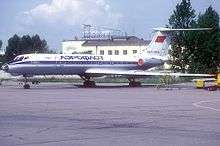Aeroflot Flight 7841
Aeroflot Flight 7841 was a scheduled Soviet domestic passenger flight from Minsk to Leningrad (now Saint Petersburg), which crashed on 1 February 1985 killing fifty eight people on board.[1] Twenty-two people (including three crew members) survived the accident.[1] The crash was caused by engine failure brought on by ice ingestion. On 8 May 1985 the Tupolev Tu-134A was officially written off.[2]
 Soviet Aeroflot Tupolev Tu-134A, similar to that involved in the accident | |
| Occurrence | |
|---|---|
| Date | 1 February 1985 |
| Summary | Double engine failure, due to ice ingestion |
| Aircraft | |
| Aircraft type | Tupolev Tu-134A |
| Operator | Aeroflot |
| Registration | CCCP-65910 |
| Flight origin | Minsk-2 International Airport (MSQ/UMMS), Byelorussian SSR |
| Destination | Leningrad-Pulkovo Airport (LED/ULLI) Russian SSR |
| Occupants | 80 |
| Passengers | 74 |
| Crew | 6 |
| Fatalities | 58 |
| Survivors | 22 |
Aircraft
The Tupolev Tu-134A, registration number CCCP-65910, serial number 63969, involved in the accident was manufactured on 11 May 1982 and had 448 completed flight cycles prior to the accident, having entered service on 8 June 1982.[2][1] Tu-134s are equipped with two tail-mounted Soloviev D-30 turbofan engines.[3]
Crash
Six seconds after takeoff, at an altitude of 35 m (115 ft) and with a speed of 325 km/h (202 mph), a rapid loss of power occurred, accompanied by pops and Jet Pipe Temperature (JPT) overheating.[1] The crew levelled the wings and continued climbing, when the co-pilot reported a failure of the left engine to air traffic control.[1] At 65 seconds after takeoff, an excessive vibration alarm indicated failure of the right engine.[1] Then, at an altitude of 240 m (790 ft) and a speed of 325 km/h (202 mph), the right engine failed, while the aircraft was still in the clouds.[1] In an attempt to retain speed, the captain initiated a descent with a vertical speed of 7 m/s.[1] The aircraft was descending onto forest, with some trees up to 30 m in height.[1] At an altitude of 22 m (72 ft) and with a five-degree right bank angle, the aircraft impacted the tree tops. The aircraft continued hitting the trees and ultimately burned down except the aft portion.
The crash site was located 10 km (6.2 mi) east of Minsk National Airport by search groups after three hours.[4][1]
Investigation
The investigation concluded that both engines failed due to ice ingestion, which led to compressor stall, destruction of the compressors and over-temperature of the turbine blades.[1] Citing significant damage to the aircraft and engines, the investigators were unable to determine where the ice came from.[1]
References
- Катастрофа Ту-134А Белорусского УГА в районе а/п Минск-2 (in Russian). Airdisaster.ru. Retrieved 21 July 2014.
- "Туполев Ту-134АК Бортовой №: CCCP-65910" (in Russian). Russianplanes.net. Retrieved 21 July 2014.
- "Tu-134". Tupolev. Archived from the original on 31 January 2015. Retrieved 31 January 2015.
- "Accident description". Aviation Safety Network. Retrieved 21 July 2014.